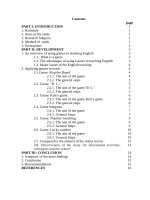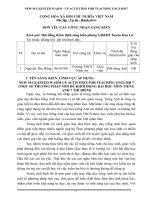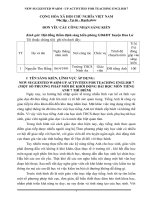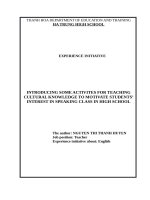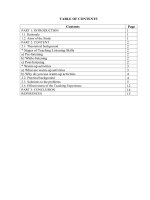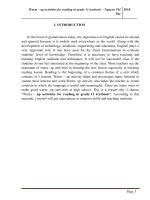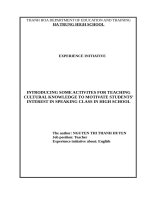Warm up activities for speaking class in high school
Bạn đang xem bản rút gọn của tài liệu. Xem và tải ngay bản đầy đủ của tài liệu tại đây (352.79 KB, 46 trang )
Vinh unversity
Foreign language department
warm-up activities for speaking
class in high school
(ho¹t động khởi động lớp cho giờ
học môn nói ở các trêng phỉ th«ng)
Supervisor :
Student
Class:
:
m.a.
Nguyen Thi Van Lam
Cao Thi Hue
vinh ,5/2005
42A2
Acknowledgements
The study would not have been completed without the invaluable
assistances and unflagging encouragements of many people.
First of all, I would like to express my great gratitude and special
thanks to my supervisor, M.A Nguyen Thi Van Lam who has contributed to
my study with many excellent suggestions, detailed critical comments and
encouragements.
My greatest debt is to Dr Ngo Dinh Phuong and many other lecturers
at Foreign Language Department in Vinh University who have given me
useful advices and favourable conditions for the completion of my thesis .
I would like to express my gratitude to Miss Mindy who has
wholeheartedly helped me much with precious sources of materials.
My sincere thanks goes to all teachers of English and students in Yen
Dinh I high school whose endless enthusiasm has helped me to carry the
surveys which are very useful for my thesis.
I am really in debted to my beloved family and my friends who
encourage me, give me useful suggestions, lend me materlials and are always
by my side during the process of conducting the study. They help me to stay
on my toes and complete the thesis .
Although the study has been done with all my attempts, my limitations
of ability and knowledge may cause mistakes in the thesis. Therefore, I am
looking forward to receiving the sincere comments from all of you!
Vinh,May
2005
Cao Thi
Hue
abstract
Warm- up activities in language class has been discussed for a long
time and are still on debate. Speaking skills are on the same boat. It is one of
the most outstanding topics in methodology and is a controversial topic as
well. Acknowledge this fact and the importance of two above aspects, the
thesis with the title “warm up activities for speaking class in high school” has
been done with the hope to have a small contribution to language teaching
method and to provide some useful knowledge about them.
Mastering the process of conducting a scientific research, the author has
carried out the thesis in a logical order. Firstly, the reasons for choosing the
topic are presented, then the aims, the scope, the methods and the design of
the study are dealt with in turn in the first part called “introduction”.
In the “investigation” part, the author does not have the ambition
to cover all things related to warm- up activities in general. The study only
focuses on the most typical things that are important to the thesis. Before
presenting some warm- up activities for speaking class in high school, the
thesis has been gone through all necessary theoretical concepts concerned
with the topic such as the Communicative Approach (C.A), the nature of
speaking and warm- up activities.
Then the thesis includes the surveys on the situation of teaching and
learning English speaking skills and the state of using warm- up activities in
high school. The results gained in the surveys provide useful sources for the
completion of the thesis. Basing on the results, the author suggests some best
warm- up activities for speaking class. These activities are basically oral.
To complete the this study, many sources of materials are used,
especially the author has exploited to the maximum
the website
“google.com”
Some selections of pictures which can be used in speaking class in
warm up’s time are also introduced in the thesis.
In general, the thesis has been conducted with the purpose of handing
teachers and students of English some useful knowledge about and some
suggestions of both speaking skills and warm- up activities.
It is hard for the author to deal with everything about them but
hopefully, the thesis has introduced something new, creative and
advantageous for foreign language teaching.
Table of contents
Acknowledgements
Abstract
Table of contents
abbreviations
Part I:
Introduction
1. The Reasons for choosing the study
2. The Aims of the Study
3. The Scope of the Study
4. The Methods of the Study
5. The Design of the Study
Part II:
I
II
IV
VI
1
3
3
4
5
Investigation
Chapter 1 : Theoretical background
1.1 An over view on C.A
1.2 Nature of speaking
1.2.1 What speaking is
1.2.2. The position of speaking skills among four language skills
6
8
8
9
1.2.3. Speaking activities
10
1.2.3.1. A successful speaking activity
12
1.2.3.2. Problems with speaking activities
13
1.2.4. Principles to teach speaking in C.A
15
1.3 . Warm- up activities
16
1.3.1 Definition
16
1.3.2 Teaching aims of using warm- up activities
17
1.3.3 The role of warm- up activities in speaking class
20
1.3.4 Principles of using warm- up activities in speaking class in high school
22
Chapter 2:
Situation analysis
2.1 The situation of learning speaking skills in high school
2.2 The situation of teaching speaking skills in high school
2.3 The situation of using warm- up activities in high school
24
26
29
Chapter 3: Suggested warm - up activities for speaking class in high
school
3.1. Songs
3.1.1 Why songs ?
3.1.2 Which songs?
3.1.3 How to teach with songs
3.1.4 Suggested songs
30
30
30
3.2 Games
3.2.1 Why games ?
3.2.2. Which games ?
3.2.3 Suggested games
32
32
32
33
31
3.3 Story –telling basing on given picturestelling basing on given pictures
40
Part III: Conclusion
42
Referrences
Appendix
44
45
1. Selections of pictures
2. Questionnaire
List of abreviations
C.A: Communicative Approach
e.i: it means that
List of tables
1. Table 1
2. Table 2
3. Table 3
List of pictures
1. Picture1
2. Picture 2
3. Picture3
4. Picture 4
.
26
28
29
30
31
33
34
Part I: Introduction
1. The Reasons for Choosing the Study
In the course of global integration, English has become the vital device
for communication in all fields. It is as a bridge which brings people from
different countries in the world closer. Therefore, humanbeings is
appreciating the role of English more and more .
English has been considered to be the most necessary subject for
students in all levels of educational systems. The demand of learning English
is gradually increasing. To meet the need of everybody, education is required
to be improved, how to find the most effeective method in teaching English is
the concern now.
Nowadays, the Communicative Language Teaching Approach seems to
be dominant, e. i the communicative competence is the goal of language
teaching. Many great changes have been made in classroom’ atmosphere:
learners play active and possitive roles during the classtime and learners –telling basing on given pictures
centered classroom is reached.
In the time of C.A, how to teach four basic language skills: speaking,
listening, reading, and writing is taken into serious consideration. Among four
of them, speaking takes the highest position.
However, in fact, in high school, speaking is not paid a lot of attention
to. Teachers and students find it difficult to start talking in the target
languages.
Actually, it is not easy to get students start talking in English at the
beginning of the class. How to encourage students to speak English and join
speaking activities is the worry of many teachers.
Facing with that demand of methodology, teachers are required to be
more careful and skillful in preparing the lesson plan in which warm- up
activities play a very important role. To gain a successful speaking class, the
very essential element is motivation which is created from the beginning of
the class, warm-up activity–telling basing on given picturesthe starting point of the lesson must be very
interesting so that it can stimulate students to speak English. Surely, good
opening leads to successful things .
In fact, there have been many people writing about warm- up activities
and some graduation thesises about these as well. However, these materials
are too general and difficult to apply in Viet nam. Moreover, teachers and
students in high school, actually, are not aware much about the importance of
warm- up activities .These problems have been tossed in the sleep of the
author.
Last but not least, it is insufficient if going wihtout saying that
speaking is the most favourable skill for the author and the thesis has been
done with the wish that it can contribute a bit to a better future of teaching and
learning to speak English.
To be a teacher of English in the very near future at the time the C.A is
widely applied in teaching foreign language, the study entitled “ Warm- up
activities for speaking class in high school” has been conducted with the
hope to make teachers and students more aware of the importance of warmup activities which play the role of ice breakers in a few first minutes of
speaking class.
2. The Aims of the Study
For the reasons mentioned above, the thesis has been done with the
wish that it can contribute to the improvement in teaching English in general
and in teaching speaking skills in particular.The thesis aims to :
- Provide an overview on C.A and the nature of speaking skills
- Present some general knowledge about warm- up activities
- Suggest some typical warm- up activities for teaching speaking skills
- Give some features of the situation of teaching and learning speaking skills
and using warm- up activities in high school
- Help teachers and students be aware of the role of warm- up activities in
speaking class
3. The Scope of the Study
Warm- up activities are varied, so for different skills at different levels
we have different choices. That is why it is impossible for the author to cover
all things related to the topic of the study. Only the most necessary knowledge
about speaking skills and warm- up activities are mentioned in the thesis.
Further more, it is too broad to carry out the thesis discussing all levels
of students. Thus, the thesis focuses on students of beginning level- the
students at high school.
What is more, special attention is paid to warm- up activities which are
basically oral because they are the best to get students start talking –telling basing on given picturesget
ready for speaking class time.
In the limitation of a university graduation thesis, the author does not
have the wish to provide a too extensive topic.
4.The Method of the Study
To complete the thesis, the following methods have been used :
- Collecting information associated with speaking skills and warm- up
activities from different sources : references, books, and Internet
- Investigating and analyzing the situation of teaching and learning
speaking skills and using warm - up activities in speaking class in high in
school.
- Synthesizing and analyzing the results gained in investigating duration
to suggest suitable warm- up activities for speaking class.
5.The Design of the Study
The study consists of 3 parts :
Part I entitled “Introduction” outlines the background of the study. In this
part, information about the reasons for choosing the study, the aims, the
scope, the method and the design of the study are provided.
Part II with the title “Investigation” comprises 3 chapters:
Chapter 1 entitled “The Theoritical Background” provides all
concepts related to the study.
Chapter 2 is about the “Situation Analysis” which results from the
investigation of the factual situation of teaching and learning to speak English
and using warm- up activities at Yen Dinh I High school in Thanh Hoa.
Chapter 3 discusses “Suggested warm- up activities for speaking class
in high school”.
Part III is the “Conclusion” which gives a brief overview on the achievement
of the thesis and suggests some extensive topics relating to the thesis.
“Reference” is coming next with a list of sources of materials are
presented in detail.
The thesis ends with “Appendix” part in which some selections of
pictures which can be used as warm- up activitties in speaking class are
introduced. The questionaires of the surveys are also given in this part.
Part II: Investigation
Chapter1: Theoretical Background
1.1 An overview on C.A
The developments in teaching and learning foreign languages in recents
years have proved the scientific and effective features of the C.A. The matter
of teaching methods is still controversial but surely the C.A is the best up to
now.
As already known, in C.A the communicative competence is the goal of
language teaching. This is the most important fearture of C.A. According to
C.A, the aim of lesson plan is to develop the ability of students to use
language appropriately in specific situations. In other words, it tries to make
learners “communicatively competent” (Lasen-Freeman, 1986). Learners
should be able to select a particular kind of language and should know where,
when and with whom they should use it.
Moreover, everything carried out in classroom is done with
communicative intent. That is activities are designed to provide students with
chances to practise using language in reallife communicative contexts or to
develop the students “intergrating ability”. That also explains why all
materials used in classroom, in C.A, are authentic. To be clearer, it means that
the sources of teaching and learning materials are taken from the daily life
with realistic purposes for specific social situations. These kinds of materials
make students interested, help them be easy to understand not only the form
but also the usage of language items and improve the students’communicative
skills in real life. Obviously, in C.A the use of language is paid much more
attention to than the correct form when using it.
What is more, activities carried out in classroomare truly
communicative. That is they must be: information gap, choice and feedback.
Therefore, games, role plays, and problems–telling basing on given picturessolving tasks are used much in
communicative classtime. Theses activities, of course, are done by students in
small groups.This is a good chance for students to learn to share ideas and
express thier individuality. Further more, during the activities teachers play
the role of the managers, the guiders, or the monitors. They mainly act as the
advisors of the activity. Sometimes, teachers also are participants in these.
Certainly, there is no place for a teacher-centered classroom. It is replaced by
student–telling basing on given picturescentered ones. Students change their roles from passive learners into
active ones. They are actors or comminicators. They are freely talking in the
target language without or with less pauses or control of the teachers.They
learn to communicate by having interactional talks with their classmates and
exchanging information in their own ways.
In comparison to others traditional teaching methods which emphasize
the dominance of grammar, C.A is the best one which develops four language
skills (speaking, listening, writing, reading) from the begining equally. This
approach seems to be the reaction against to the Grammar-Translation Method
and the Audiolingual Method which did not stress the communicative use of
language.
One of the main challenges of the C.A is to intergrate the functions of
language (informaion retreival, problem solving and social exchanges) with
the correct use of structures. The question is how to combine communicative
fluency with formal accuracy.
To answer this question, teachers are required to be very careful when
preparing the lesson plans.
1.2..The nature of speaking
1.2.1. What speaking is
Speaking is an interactive process of constructing meaning that involves
producing and receiving and processing information (Brown, 1994, Burn and
Joyce, 1997). Its form and meaning are dependent on the context in which it
occurs, including the participants themselves, their collective experiences, the
physical environment and the purposes for speaking .
It is often spontaneous, open-ended and evolving. However, speech is
not always unpredictable. Language functions that tend to recur in certain
discoures situations, can be identified and charted (Burn and Joyce, 1997).
Speaking requires that learners not only know how to produce specific points
of language such as grammar, pronunciation, or vocabulary but also that they
uderstand why, when, and in what ways to produce language.
Finallly, speech has its own skills, structures and conventions different
from written language.
1.2.2. The role of speaking skills
Of all four language skills, speaking seems intuitively the most
important : people who know a language are referred as “speakers” of that
language as if speaking included all others kind of knowing and many if not
most foreign language learners are primarily interested in learning to speak.
The people who are good at speaking are ones who master not only grammar,
pronunciation, intonation, vocabulary but also the social contexts in which
language is used. In other words, speaking, in real sense, includes both
producing language and applying it in different circumstances in life. In short,
in methodological sense, speaking skills are closely related to all other
language skills.
Nowadays, English is the international language, so the ability of using
English in communication is very necessary. Admittedly, speaking is the
fastest way to exchange information, therefore, more and more people are
trying to learn English speaking skills on the purpose of communicating in the
modern world. This tendancy puts speaking in the highest position among all
four language skills.
It can not be denied that speaking has its own outstanding forces. The
fact is that besides speaking, writing, a productive skill, is also a very useful
device in social communication. However, it is quite different from speaking
which is a spontaneous activity and we have to spend less time on preparing
the content of a speech than composing an essay.
In biological sense, talking is the first ability that one person posesses.
This also helps us be sure that producing an utterance is easier than giving a
composition.
What is more, when we speak, we not only produce language items but
also express our attitude by using body language such as facial expression,
gestures... and by the rhymth of the utterances. These extral factors contribute
much to the success of an interactional talk . That is the typical force of
speaking that no other skills has. It is this characteristic that makes speaking
to be appreciated higher and higher.
Teaching speaking skills, therefore, is forced to be developed much to
meet the demand of learners.
1.2.3 Speaking activities
1.2.3.1 A successful speaking activity
It is not easy to carry out successfully a speaking activity in classroom
if we are not sure about the characteristics of a model of it. There have been
many arguments about what a successful speaking activity is. These following
characteristics are accepted the:
The first characteristic is that learners talk a lot. Teachers should know
that how to get students talk in the target language as much as possible in the
time of the activity is the most important. If most of the classtime is taken up
with the teacher talk or pauses and very few chances are for students’ talk
when carrying out an activity, it can not be considered to be successful. At the
time of C.A, most of the classtime is allotted to the students .Teachers only
play the role of guiders, so they should let students be free to express their
understanding in their own ways.
The second one is high motivation. It is one of the most important
criteria to evalutate a speaking activity. How to create high motivation to
students in class and to make the classroom dynamic is the matter that
teachers should care when conducting an activity because it is these factors
that lead students to study effectively. To achieve these, activities used in
class must be interesting, i.e they are in favour of the students, right for
students’interests, and they must be carried out in group work, pairwork or
classwork. Teachers of English, therefore, should be more careful and
wholehearted when planning lessons.
The third one is evenparticipation. It means that classroom discussion
attracts equal contibution of all students. If classtime is dominated by a
minority of talkative participants and no chance of talking is used by the
worse during the time of activities, of coures, these can not be seen as
successful speaking activities. Indeed, unevenpartipation may badly affect the
improvement of speaking ability of the students because some worse students
have a few practice and day by day they may loose their confidence.
Last but not least, it is necessary for teachers to remember that
language of speaking activities must be at the acceptable level. In other words,
their language should be relevant to students’degree, easily comprehensible to
students and of an acceptable level of language accuracy. Obviously, if the
language is too difficult, students will be afraid and pressed when they try to
speak English or they may not enjoy these activities. That is why before
deciding which activity is the suitable one, teachers should pay attention to its
language’s requirement.
1.2.3.2 Problems with speaking activities
Admittedly, it is quite difficult to talk in the target language even
though you are the teachers of foreign languages. How to carry out a speaking
activity well and to get students involved in them is the concern of teachers
when teaching English as a second language.
There are many problems in teaching and learning English speaking
skills faced by teachers and learners. The author is going to discuss some
popular ones with the hope of helping teachers avoid or overcome those.
The first matter is the inhibition feeling of students. Unlike reading,
writing and listening activities, speaking requires some degree of real time
exposure to an audience. Learners are often inhibited about trying to say
things in a foreign language in the classroom: they are worried about making
mistakes, fearful of criticism or losing face, or simply of the attention that
their speech attracts. Teachers should be able to help students to overcome
this feeling in the speaking class.
The second problem that learners may get into is that they have nothing
to say. Even if they are not inhibited but you often hear learners complain that
they can not think of anything to say, they have no motive to express
themselves beyond the guilty feeling that they should be speaking. This may
happen because of the complex of the topics used or the language of activities
which are above the degree of learners.
In speaking class, students sometimes use their mother tongue much
more than the target language. That is one problem that teachers should care
about. In classes where all, or a number of, the learners share the same mother
tongue, they may tend to use it because it is easier and because it feels
unusual to speak to one another in a foreign language, and because they feel
less “exposed” if they are speaking their mother tongue. If they are working in
small groups , it can be quite difficult to have some classes-particularly, the
less disciplined or less motivated ones , keep talking in target language. This
is one of the disadvantage of using groupwork.
One more difficulty occurs in speaking class that is low or uneven
participation. Only one partipant can talk at a time of he or she is to be heard,
and only in a large group, this means each one will have only very little
talking time. This problem is compouned by the tendency of some learners to
dominate while others, speak very little or not at all. The task of teachers is to
monitor the class time in order to provide chances of talking to all students in
the class fairly.
When preparing activities for speaking class, teachers of English
should pay much attention to the above problems, so that the class time will
be successful and useful to students.
1.2.4. Principles to teach speaking skills in C.A
How to teach speaking skills the most effectively is a big
controversial topic. Different authors give different opinions about the
principles of teaching speaking skills. It is important to remember that the
goal in language use is natural communication, that is why the principles to
teach speaking are divided into groups basing on the level of students. Forseth
Et al (1994) presents principles in teaching speaking for the beginning level
( students in high school) in the C.A as follows:
Limit the objectives to avoid overwhelming the learners. Teachers
should provide students with enough structure practice so they can begin
interacting at a basic level. This will reduce students’fear and encourage more
speaking and later, more free production can come after the structured
practice. If the objectives are not limited, learners may be confused and
difficult for them to understand the lesson
Mix speaking activities with comprehension work : that is, have
students listen to the teachers or each other before they speak. When students
listen before they speak, it leads to more natural speech. Comprehension work
fosters an interaction between speaking and listening, so speaking should
involve first listening task as well.
Provide activities which involve dialogues and functional use of
language. That is, activities carried out in classroom should focus on language
use rather than knowledge about language, and students are supplied with not
only the form but also its meaning. What is more, activities should involve
dialogues because dialogues are more concrete and less controlled than
structured drills. This makes students more communicatively competent.
Do not emphasize the significance of mistakes
Students are often afraid of being corrected by teachers and their classmates
when they speak English and this prevents the students much from making
speech. Teachers should remember this principle and apply it in class to avoid
stop students ‘talking and encourage them to express their ideas without the
fear of being corrected.This principle follows an important feature of C.A,
that is the focus on meaning and communication rather than grammatical
accuracy (though such structural errors can also hinder communication).
Certainly, teachers should not ignore all mistakes of students but they had
better pay attention to problems affecting clear communication or language
already taught to the students.
State the purpose of the activity to the students
This may provide a direction for the student’s work. They are provided with
context or focus to help comprehension and this also allows the learners to
concentrate on the task and understand why they are doing it. This is a good
guide for students to start working.
1.3 Warm-up activities
1.3.1 Definition
Warm-up activity is a kind of short activities which is used to break the
“ice” in classroom and make it “hot” from the beginning of each period of
language class. They are short, simple and interesting enough to motivate
students to learn a foreign language better.
1.3.2 Teaching aims of using warm- up activities
Instead of starting a new lesson by checking the previous lesson
mechanically, teachers can use warm- up activities for different teaching aims.
Here are 3 main teaching aims of carrying out warm- up activities in
language class:
1.3.2.1. Warm up to get class started
By doing these following things , teachers can start the lesson:
- Greet students individually, ask them how they are feeling and coax a
little small talk from them
- Ask if students can remember what we did in the last lesson
- Check if the students can remember a specific teaching point from a
previous lesson
- Set a riddle
- Do something completely unexpected
- Say something provocative and controversial
- Comment on some aspect of the students’ appearance
- Tease somebody about something
- Get the students to report back on their homework
- Ask each student for an example of something positive and something
not so positive from their life
- Tell some good news and some bad news from your life and ask
students to do the same
- Take up some conversation points we recently discussed in class
- Question the students on what they think about some topical issues
- Ask the students to describe an aspect of their culture
- Get the students to explain something to us
- Request advice about something
- Get the student to each ask us a question or two
- Start the lesson with a short silence, a meditation or a prayer
- Praise individual students or the whole class on their progress
- Just stand or sit silently in front of the class and wait for a response
1.3.2.2. Warm-up to get people talking
By asking these questions, teachers can break the “ice” in the
classroom at the beginning and get students talking
- What were you talking about when I came into the room?
- What did you do in your previous lesson?
- What did you do lastnight ?
- What are your plans for this evening /the coming weekend /the
holidays?
- What have you been reading recently?
- What is in the news today?
- Has anyone read their horoscope this week?
- Why is it busy/ quite in town today?
- What is new at home/ at school/ at work or in general?
- When did you last use your English?
- Has anyone seen or heard the weather forecast?
- I think my watch is wrong . What is the exact time now.?
- What did you have for breakfast this morning?
- I have just bought a new....(shirt).What was the last thing you bought?
- At the last lesson you predicted the lottery result. Did you have any
number correct?
- Last week, we each guessed the score in the Cup Final? Did anyone
get it right ?
- I read/ heard/ saw yesterday that....What do you think?
- Did anyone see that program about...on Tv last night ? What did you
think of it?
- Is anyone missing? When was the last time he/ she was here?
- What would you like to do today?
1.3.2.3 Warm up to lead students into the new lesson
By doing one of the following things , teachers can both warm the class
up and lead students into the focus of the coming lesson
Bring in a picture
Tell a joke
Tell an anecdote or a story
Play or sing a song
Read or ask a student to read out a short text or a related topic
Begin with a quotation or a proverb
Ask a rhetorical question
Draw something unclearly on the board and get students to guess what it is
Mime the topic and do some details connected with it
Brainstorm associated words and concepts
Make the topic the subject of a quick “20 questions”section
Revise structures and vocabulary you expect to come up
Get students to guess what the topic is from a list of key
Expressions associated with it
Tell the students what you plan to do today and tell them why
Give each student a card with a word related to the topic written on it
Tell students that they have 2 minutes to think about their words in
silence.Then they have to share their ideas and associations with the class.
As a simple guessing game , demonstrate what you are going to do today,
without actually saying what it is
1.3.3 Principles of using warm up activities in speaking class in high
school
As mentioned above, we can not deny the necessity of using warm- up
activity in speaking class in particular, in language class in general. However,
it may cause bad effects on lessons if teachers do not understand the princples
of using warm- up activities in speaking class in high school.
The first and the most important principle is good preparation. Teachers
can not bring into play the role of warm-up activities if they are not well
prepared before class. All things relating to the activity used in class should be
ready and in good condition in advance. If not, it will waste classtime and
make students bored.
To have a good preparation, teachers should know for sure the purpose
of using this activity( to get students talk, to start class or to introduce the
content of the coming lesson), how to carry out it and how it is carried the
most effectively and what are necessary for the activity. Acknowledge these
factors helps teachers be clear and correct in choosing an activity.
The second principle is that activities must be short and simple. That is
these activities take only about five to ten minutes at the maximum, and these
are easy for the comprehension of the students. They help students to relax
and loose pressure–telling basing on given pictures a good preparation before beginning a new lesson. If
they are too difficult, they will ask students to work alot, make them tired and
they can not be motivated to study well in the coming classtime. If the warmup activity is too long to finish, teachers may not complete the compulsory
lesson as planned, because warm-up activities only play the role of bringing
inspiration to students before they start new lesson.
Another principle is that chosen activities should be as interesting as
possible. As already mentioned , warm- up activity acts as icebreaker in few
first minutes of the class and give students motivation. It is this feature that is
the force of warm- up activities, without it, warm- up activities become
useless. That is why it must be exciting enough to stimulate the students, help
them be in good mood during the classtime. Therefore, teachers should be
able to know what the students like, what they are interested in and what are
suitable for the psychological characteristics of the students .
One more principle is that warm- up activity ‘s language must be at the
suitable level to students. As we know, only little time spent on it and it is
simple, so the language level that the activity requires must be simple as well.
Students will find eager to join the activity if the language used is easy and
popular with what they are taught. They may loose their keen if they have to
work hard to find the vocabulary to use in this activity.
What is more, warm- up activities must be varied. Do not carry out the
same type of activity for all class time. Teachers should think of different
types of warm- up activities and use them alternatively and flexibly. Taking
this principle in a special consideration will take the boring and monotony
atmosphere of the class away and make students excited about warm- up
activities.
Last but not least, for speaking class, warm- up activity must be mainly
oral. That is, it requires much of learners’ talking time, so that they will not
find hard to get involved in the new speaking period. Teachers had better be
careful in selecting the types of warm- up activiy in order to take advantages
of them the most.
To sum up, to bring into play the effectiveness of warm- up activities in
speaking class as well as in language class, teachers should take these above
principles into consideration before making decision on which activitry is the
best. Surely, it is impossible for teachers to cover all principles at the same

